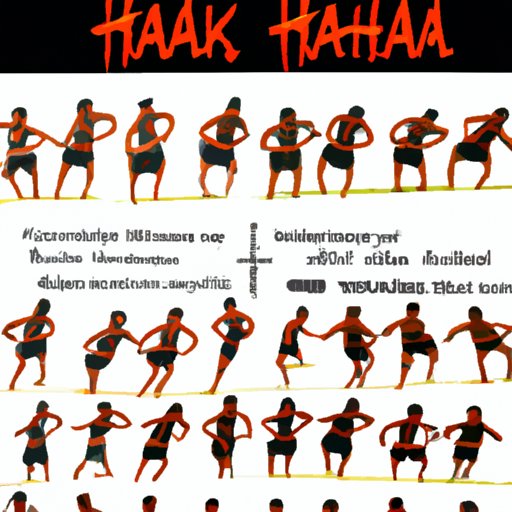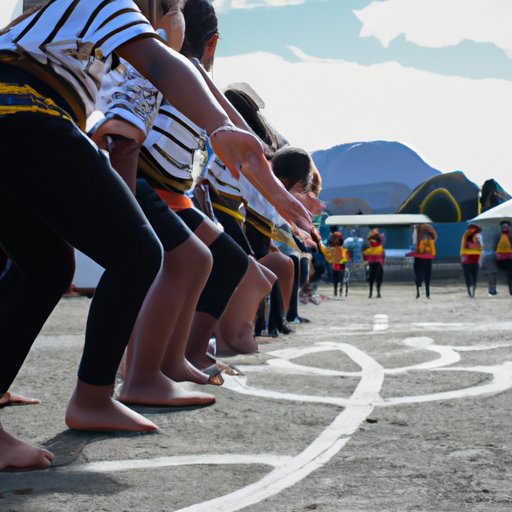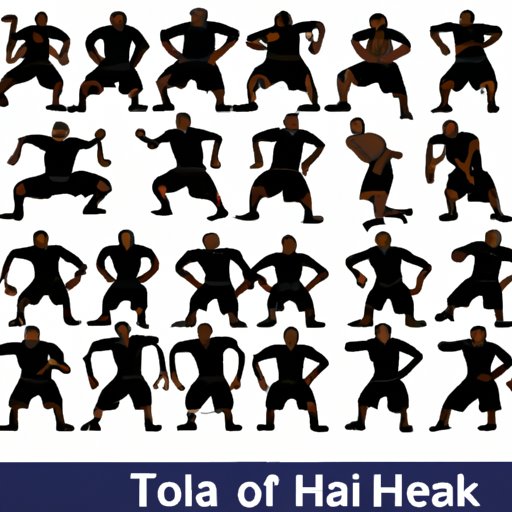Introduction
The haka dance is an ancient ritual and war cry of the Maori people of New Zealand. It is traditionally performed by men, but it can also be done by women and children. The haka is an integral part of Maori culture, with each tribe and family having their own unique version of the dance. Despite its long history and cultural importance, the haka has become increasingly popular in recent years as a way to celebrate sports victories, mark special occasions, and even as a form of protest.

Historical Overview of the Haka Dance
The haka has been around for centuries, with evidence of the Maori performing it as early as the 16th century. According to Maori tradition, the haka was first used as a way to intimidate enemies before battle. Over time, it evolved into a celebration of victory after battle, and eventually a way to mark important events, such as births, weddings, and funerals.
The haka is deeply rooted in Maori culture and traditions. Each haka is unique to a particular tribe or family, and often contains references to their history and beliefs. For example, one haka includes the words “Ka mate! Ka mate! Ka ora! Ka ora!” which translates to “I die! I die! I live! I live!” This phrase is believed to refer to a story of a Maori warrior who was killed in battle, only to be brought back to life.

Exploring the Cultural Significance of the Haka Dance
The haka is much more than just a dance; it is an expression of emotion, pride, and identity. The movements and gestures used in the haka are symbolic and have deep meaning. For example, the slapping of thighs and chest is meant to represent strength and courage, while the stomping of feet indicates unity and readiness for battle.
The haka is also an important part of Maori culture and identity. It is a way for them to connect with their ancestors and to honor and remember their past. The haka is seen as a way to show respect to visitors and to welcome them into the community. It is also used to give thanks to the gods for their blessings and protection.

Different Types of Haka Dances
There are many different types of haka dances, each with its own distinct style and symbolism. Some of the most common haka dances include:
Ka Mate
Ka Mate is the most well-known type of haka dance, and is often performed at sports matches and other events. It was composed by Te Rauparaha, a Maori chief, in the early 19th century, and is said to tell the story of his escape from death. The movements and gestures used in Ka Mate are meant to symbolize the struggle against death, and the ultimate victory over it.
Kapa O Pango
Kapa O Pango is another popular type of haka dance, and is often performed as a pre-game ritual for rugby teams. This haka was composed in 2005 for the New Zealand All Blacks rugby team, and is said to represent the battle between light and dark. The movements and gestures used in this haka are meant to symbolize the power of the All Blacks and their determination to win.
Tama Tu
Tama Tu is a haka dance that was composed by the Maori prophet Te Kooti in the late 19th century. This haka tells the story of Te Kooti’s journey to freedom, and is said to symbolize the struggle against oppression and injustice. The movements and gestures used in this haka are meant to represent Te Kooti’s resilience and strength.
Wero
Wero is a haka dance that is traditionally performed to welcome visitors to a village or marae (meeting house). This haka is said to represent a challenge to visitors, asking them to prove their worthiness to enter the community. The movements and gestures used in this haka are meant to symbolize strength and courage.
How to Perform a Haka Dance
Learning to perform a haka dance can be a rewarding experience, but it is important to understand the cultural significance of the dance before attempting to do so. Here are some tips for those interested in learning how to perform a haka:
Step-by-Step Instructions
The best way to learn how to perform a haka is to watch someone else do it. Look for videos online, or attend a cultural event where the haka is being performed. Pay attention to the movements, gestures, and facial expressions used, and try to imitate them. Once you feel comfortable with the basic steps, practice with a group of friends or family members.
Tips for Beginners
When performing a haka, it is important to remember that the movements and gestures should be done with purpose and conviction. Make sure to put your heart and soul into the performance and to stay focused throughout. Finally, be respectful of the cultural significance of the haka, and remember that it is not a performance but rather a sacred ritual.
The Impact of Haka Dances on Contemporary Society
The haka has become increasingly popular in recent years, and is now performed in a variety of settings. It is commonly used to celebrate sports victories, mark special occasions, and even as a form of protest. The popularity of the haka has helped to increase awareness and acceptance of Maori culture, and has given the Maori people a platform to express themselves and share their culture with the world.
In addition, the haka has had a profound impact on the mental health of the Maori people. Studies have shown that performing a haka can reduce stress and anxiety, boost self-esteem, and promote positive emotions. It is clear that the haka is more than just a dance; it is a powerful tool for healing and connection.
Conclusion
The haka is an ancient ritual and war cry of the Maori people of New Zealand, with deep cultural and spiritual significance. There are many different types of haka, each with its own unique style and symbolism. Learning to perform a haka can be a rewarding experience, and can help to foster a greater understanding and appreciation of Maori culture. The haka has become increasingly popular in recent years, and its impact on contemporary society has been immense. It has given the Maori people a platform to express themselves and share their culture with the world, and has helped to promote greater acceptance and understanding of Maori culture.
(Note: Is this article not meeting your expectations? Do you have knowledge or insights to share? Unlock new opportunities and expand your reach by joining our authors team. Click Registration to join us and share your expertise with our readers.)
